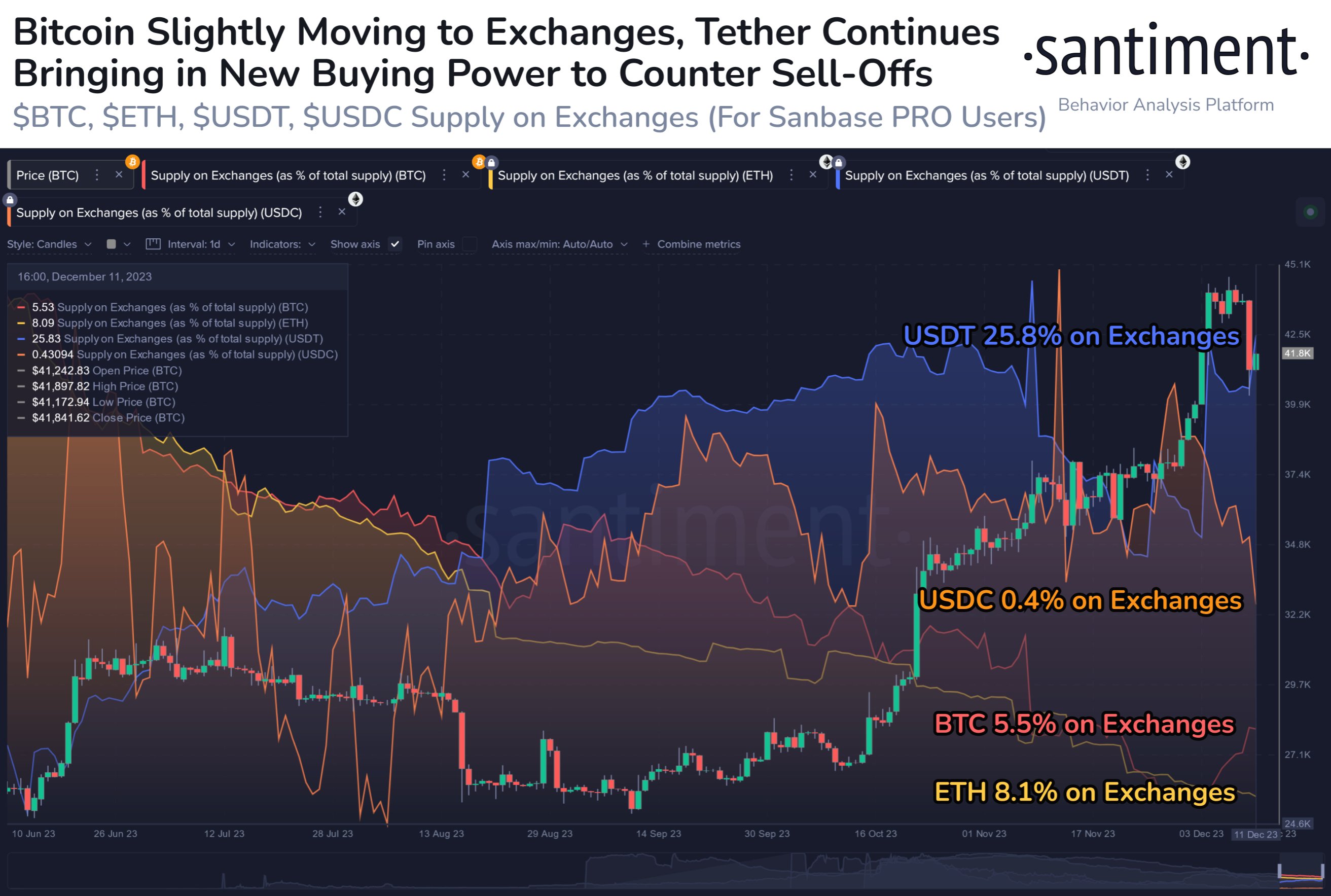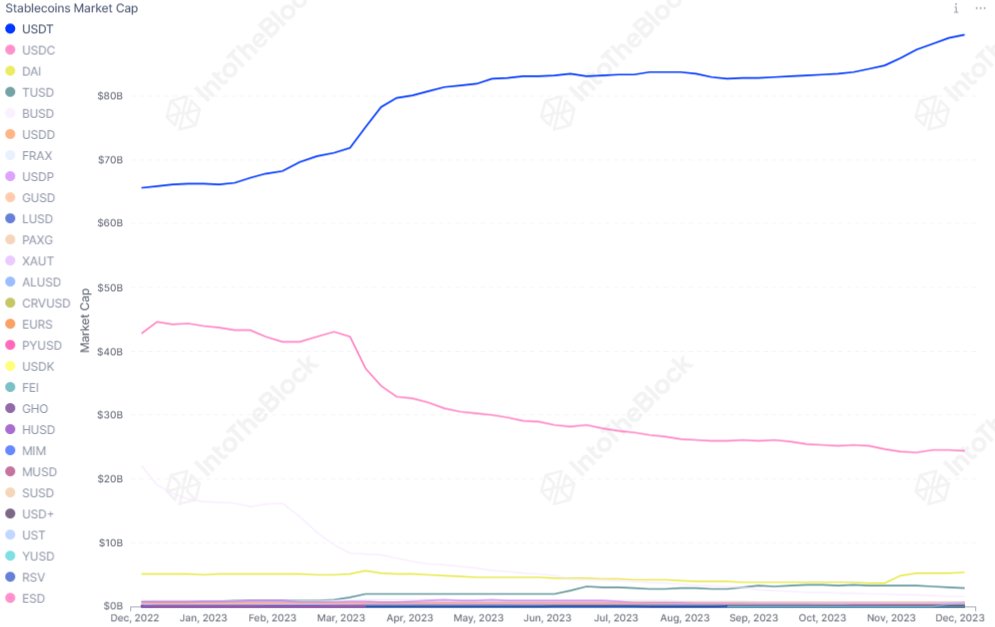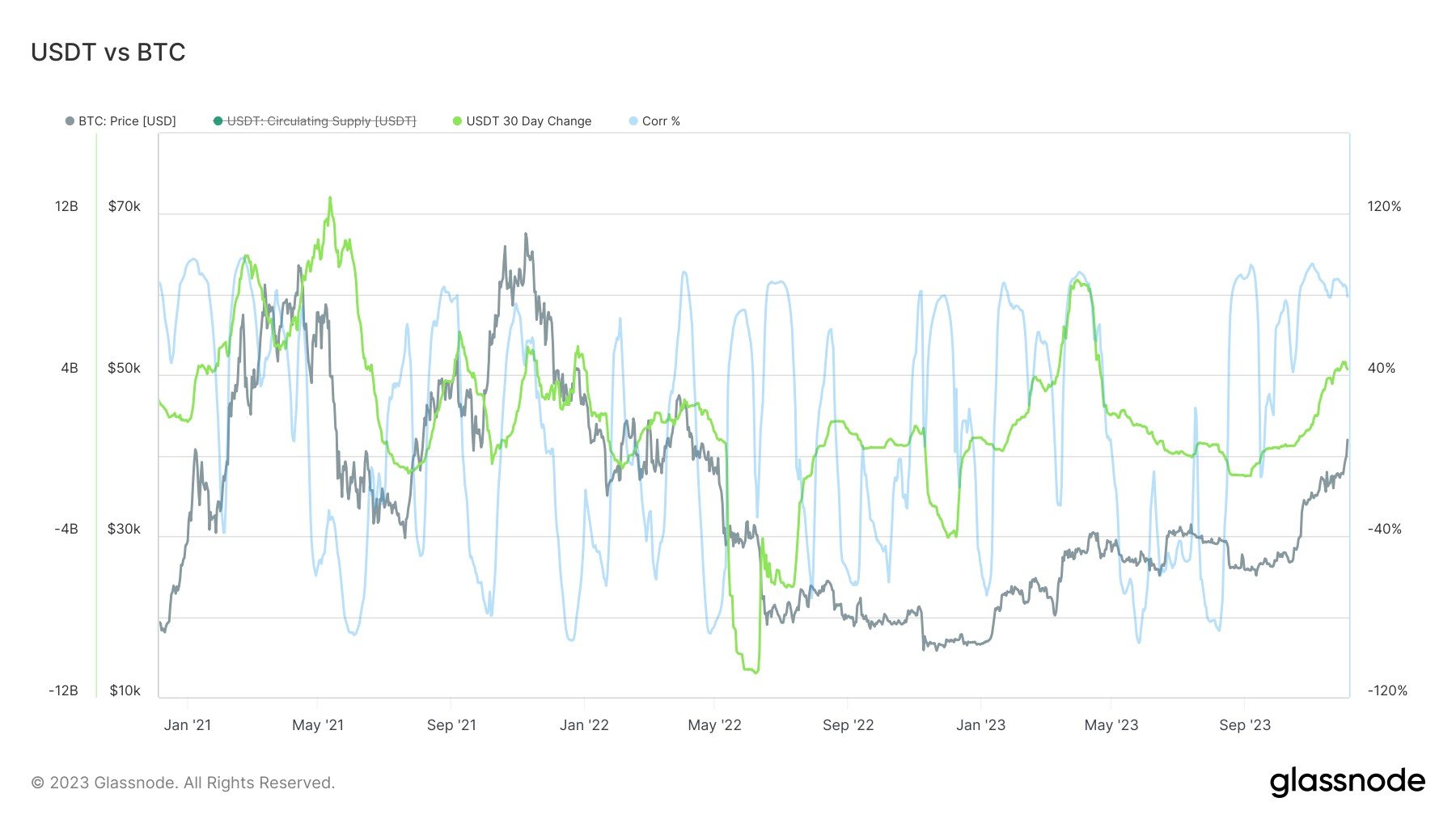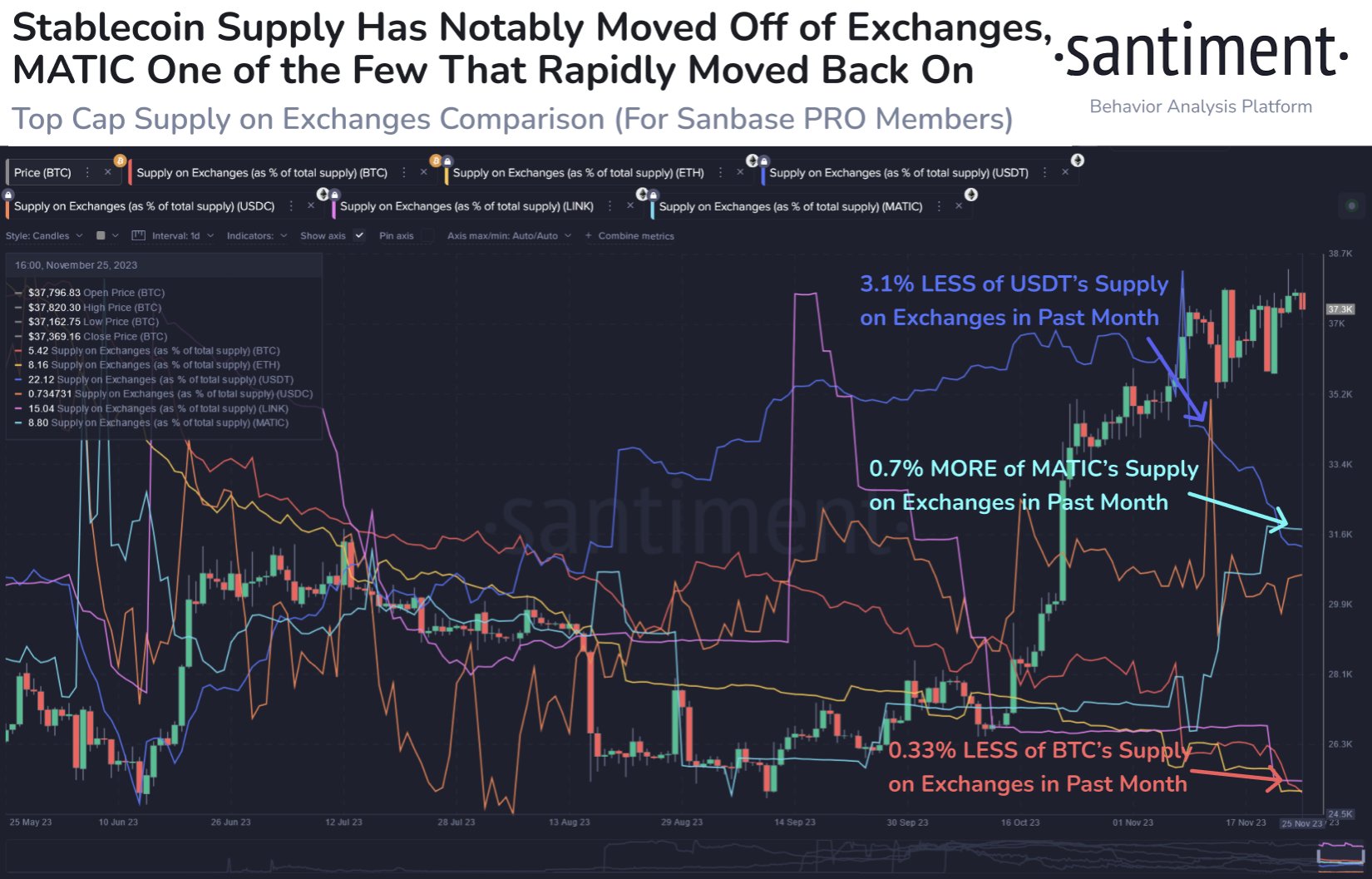Tether, the issuer of the largest stablecoin by market cap, has challenged the United Nations (UN) for its report on underground banking and money laundering infrastructure in East and Southeast Asia.
Stablecoin Takeover? Record Tether 71% Dominance Raises Questions About Crypto Future
Tether, the issuer of the ubiquitous USDT stablecoin, cemented its dominance in 2023, ballooning its market share to a staggering 71%. This explosive growth, however, comes with a chilling undercurrent: a United Nations report linking USDT to a surge in cybercrime and money laundering in Southeast Asia.
Glassnode data paints a stark picture of Tether’s ascent. Its market capitalization reached a record $95 billion in January 2024, fueled by a 40% increase in USDT supply over the past year. Meanwhile, competitors like Circle’s USDC saw their market share shrink, with USDT now commanding over 7 times the circulation of its nearest rival.
Tether Market Dominance Soars
Paolo Ardoino, Tether’s new CEO, has prioritized cooperation with U.S. law enforcement. The company boasts of freezing wallets linked to sanctions lists and recovering over $435 million in illicit funds.
However, the UN report casts a shadow on these efforts, detailing how USDT facilitates “sextortion,” “pig butchering” scams, and underground banking across Asia.
While Tether has proactively banned over 1,260 addresses linked to criminal activity, the sheer volume of illicit transactions raises concerns about the effectiveness of these measures.
Critics point to Tether’s opaque reserve backing as a breeding ground for misuse, calling for greater transparency to combat money laundering.
Tether’s Reign At Risk: Regulatory Challenges
The stablecoin market, once touted as a bridge between traditional finance and the crypto world, now faces a reckoning. Tether’s dominance is undeniable, but its association with criminal activity threatens to erode trust and trigger stricter regulations.
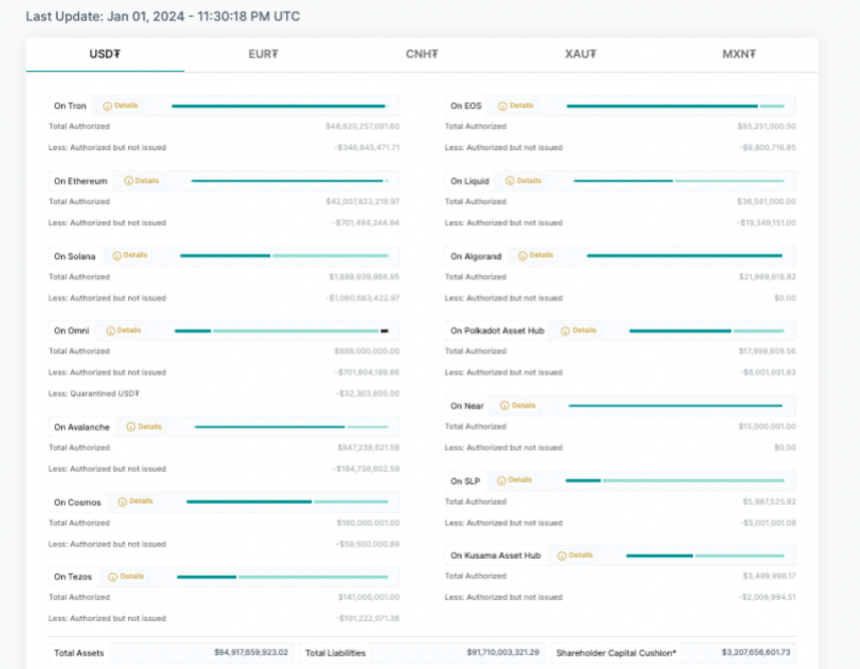
Meanwhile, Circle’s recent IPO filing hints at a potential shift in the landscape. With regulatory scrutiny intensifying, Tether’s future hinges on its ability to address concerns about transparency and combat illicit activity.
Can it clean up its act and maintain its crown, or will the tide turn towards its more transparent rivals? Only time will tell if Tether’s reign as the king of stablecoins will weather the storm of controversy.
With its historic 71% market share, Tether’s reign over the stablecoin realm is undeniable. Yet, the shadow of illicit activity threatens to eclipse its success.
As regulators sharpen their focus and competitors like Circle step into the ring, the question looms: will Tether clean house and retain its crown, or will this be the tipping point for a stablecoin revolution, reshaping the future of crypto itself?
Only time will tell if Tether’s dominance signals a bright new era for digital currencies or serves as a cautionary tale, paving the way for a more transparent and accountable crypto landscape. The gloves are off, and the fight for the future of stablecoins is just beginning.
Featured image from Shutterstock
USDC Stablecoin Momentarily Depegs to $0.74 on Binance
Circle’s USDC stablecoin spiked down to as low as $0.74 on three occasions today following a marketwide sell-off spurred by a report casting doubt over whether a spot bitcoin ETF will be approved this month.
Bitcoin to surge to $80K as stablecoins overtake Visa in 2024: Bitwise

Bitwise isn’t alone in its bullishness on stablecoins with Circle CEO Jeremy Allaire predicting the explosive growth of the sector due to a “huge appetite” for digital dollars.
Is A Mega Bull Run Incoming? Whale Transfers Over $780 Million Of Stablecoin To Binance
Data Nerd Data on December 13 shows that over the past 24 hours, the wallet “0xea8” moved 200 million BUSD from Binance, the world’s leading cryptocurrency exchange by client count.
The whale transfer caught the attention of keen crypto users, who also noted that the transfer was soon followed by a deposit of 99.95 million FDUSD, a stablecoin supported by the exchange.
Whale Address Accumulating FUSD Stablecoin On Binance
That the address is shuffling and accumulating large amounts of stablecoins is noteworthy. Data Nerd Data shows that the address has transferred over 781 million FDUSD to Binance in the last four months.
During this period, from around September, the crypto market has been recovering, edging higher on the back of improving fundamental factors.
The accumulation of over $781 million of stablecoin by the wallet controlled by an unknown individual or entity is overly bullish for crypto and Bitcoin prices.
It could suggest that a large institutional investor or group of investors is amassing stablecoins, potentially preparing for a significant market move.
Historically, large movements of stablecoins into centralized exchanges have often preceded major bull runs.
Stablecoins are vital for crypto, ensuring there is enough liquidity. Since most are pegged to the USD and can be backed by fiat, these tokens, mostly minted on Ethereum or Tron, are often used as a gateway to crypto. Therefore, their accumulation can signal increased institutional interest and potential buying pressure.
Is A Mega Bitcoin And Crypto Rally In The Making?
That the wallet address is fortifying its FDUSD base reinforces the notion that institutional investors, ahead of the possible approval of the first batch of Bitcoin ETFs in the United States, could be increasingly warming up and preparing for leading coins like Bitcoin and Ethereum to extend gains in 2024.
When writing on December 13, Bitcoin and top altcoin prices are relatively stable. To illustrate, Bitcoin is trending higher, stable above the $41,000 level after pulling back from 2023 highs of around $44,000. Crypto participants are bullish and expect Bitcoin prices to float even higher in 2024 before halving.
Binance will stop supporting BUSD in 2024. The exchange has also delisted USDC. Accordingly, USDT and FUSD are popular on Binance. However, the exchange continues to be on the Securities and Exchange Commission’s (SEC) crosshairs.
In late November, the Department of Justice (DOJ) issued a $4.3 billion penalty on Binance as settlement with the SEC, Commodity Futures Trading Commission (CFTC), and other aggrieved agencies in the United States. The deal also saw Changpeng Zhao, the founder of Binance, step down from the CEO role.
Cantor Fitzgerald CEO Is a Bitcoin Maxi and Tether Fan
Cantor Fitzgerald is one of the custodians for Tether’s $90 billion worth of treasuries.
Bitcoin Rushes To Exchanges, But This Sign Remains Positive For The Bulls
On-chain data shows an increasing trend of Bitcoin moving to exchanges, a typical bearish sign, but another signal still remains optimistic for the bulls.
Bitcoin Exchange Inflows Are Up, But So Are USDT Deposits
According to data from the on-chain analytics firm Santiment, BTC has been flowing into exchanges recently. The relevant indicator here is the “supply on exchanges,” which keeps track of the percentage of a cryptocurrency’s total circulating supply that’s currently sitting in the wallets of all centralized exchanges.
When the value of this metric goes up, it means that the investors are making net deposits of the asset into these platforms, while a decline implies outflows are taking place.
What effect either of these trends might have on the market depends on the type of cryptocurrency in question. Santiment has shared the below chart, which shows how the supply on exchanges has recently changed for four assets: Bitcoin, Ethereum (ETH), Tether (USDT), and USD Coin (USDC).
As displayed in the above graph, the Bitcoin and Ethereum exchange supplies had both been on the decline earlier, but recently, BTC has diverged from this downtrend and registered some net deposits.
These deposits first started after BTC finished its rally to $44,000 and took to sideways movement. Generally, one of the main reasons why holders might deposit their coins to exchanges is for selling purposes, so these recent inflows can be a sign that selling has been taking place.
The uptrend in the supply on exchanges also became a bit sharper in the leadup to the asset’s latest plunge, suggesting that the inflows have indeed been adding to the selling pressure.
From the chart, it’s also visible that the Bitcoin supply on exchanges hasn’t yet reversed its trend, a potential indication that selling hasn’t completely exhausted yet.
Meanwhile, Ethereum has continued to see supply exit these central entities, implying that investors of the cryptocurrency are possibly still participating in net accumulation.
Something that could prove to be positive for BTC, though, is the fact that the Tether supply on exchanges has risen since the plunge. Investors usually make use of stablecoins like USDT and USDC whenever they want to escape the volatility associated with coins like BTC and ETH, but such investors generally only do this as a temporary measure.
When the holders plan to leave the cryptocurrency sector as a whole, they do so through fiat instead. Opting for stablecoins instead, thus, means that they intend to stay in the market and possibly eventually return back towards the volatile side.
Sizeable swaps from stables into Bitcoin and others can naturally provide a buying boost to their prices, so exchange inflows of them can be a bullish sign for these volatile assets.
The most bullish combination is when BTC rallies while the USDT exchange supply does the same, as such a trend suggests that fresh capital is entering into the sector.
In the current case, the Tether exchange supply has gone up at the expense of BTC’s price, so only a rotation of capital has occurred. Nonetheless, the fact that not all capital has exited the sector as a whole can still be an optimistic sign for the rally’s return.
BTC Price
Bitcoin had plunged towards $40,000 yesterday, but the coin has already made some swift recovery as it’s now trading around the $41,700 level.
Bitcoin Rushes To Exchanges, But This Sign Remains Positive For The Bulls
On-chain data shows an increasing trend of Bitcoin moving to exchanges, a typical bearish sign, but another signal still remains optimistic for the bulls.
Bitcoin Exchange Inflows Are Up, But So Are USDT Deposits
According to data from the on-chain analytics firm Santiment, BTC has been flowing into exchanges recently. The relevant indicator here is the “supply on exchanges,” which keeps track of the percentage of a cryptocurrency’s total circulating supply that’s currently sitting in the wallets of all centralized exchanges.
When the value of this metric goes up, it means that the investors are making net deposits of the asset into these platforms, while a decline implies outflows are taking place.
What effect either of these trends might have on the market depends on the type of cryptocurrency in question. Santiment has shared the below chart, which shows how the supply on exchanges has recently changed for four assets: Bitcoin, Ethereum (ETH), Tether (USDT), and USD Coin (USDC).
As displayed in the above graph, the Bitcoin and Ethereum exchange supplies had both been on the decline earlier, but recently, BTC has diverged from this downtrend and registered some net deposits.
These deposits first started after BTC finished its rally to $44,000 and took to sideways movement. Generally, one of the main reasons why holders might deposit their coins to exchanges is for selling purposes, so these recent inflows can be a sign that selling has been taking place.
The uptrend in the supply on exchanges also became a bit sharper in the leadup to the asset’s latest plunge, suggesting that the inflows have indeed been adding to the selling pressure.
From the chart, it’s also visible that the Bitcoin supply on exchanges hasn’t yet reversed its trend, a potential indication that selling hasn’t completely exhausted yet.
Meanwhile, Ethereum has continued to see supply exit these central entities, implying that investors of the cryptocurrency are possibly still participating in net accumulation.
Something that could prove to be positive for BTC, though, is the fact that the Tether supply on exchanges has risen since the plunge. Investors usually make use of stablecoins like USDT and USDC whenever they want to escape the volatility associated with coins like BTC and ETH, but such investors generally only do this as a temporary measure.
When the holders plan to leave the cryptocurrency sector as a whole, they do so through fiat instead. Opting for stablecoins instead, thus, means that they intend to stay in the market and possibly eventually return back towards the volatile side.
Sizeable swaps from stables into Bitcoin and others can naturally provide a buying boost to their prices, so exchange inflows of them can be a bullish sign for these volatile assets.
The most bullish combination is when BTC rallies while the USDT exchange supply does the same, as such a trend suggests that fresh capital is entering into the sector.
In the current case, the Tether exchange supply has gone up at the expense of BTC’s price, so only a rotation of capital has occurred. Nonetheless, the fact that not all capital has exited the sector as a whole can still be an optimistic sign for the rally’s return.
BTC Price
Bitcoin had plunged towards $40,000 yesterday, but the coin has already made some swift recovery as it’s now trading around the $41,700 level.
Tether Launches New Security Policy, Freezes 41 Sanctioned Wallets
Stablecoin issuing company Tether has announced a new security policy aimed at protecting the crypto ecosystem from bad actors. In addition, the USDT issuer is looking to enhance its cooperation and relationship with law enforcement agencies.
Tether Freezes 41 New Wallets Following New Security Policy
In a blog post on December 9, Tether stated it would be introducing a voluntary wallet-freezing initiative designed to counter the transactions associated with Sanctioned Persons on the Office of Foreign Assets Control (OFAC) Specially Designated Nationals (SDN) List.
According to Tether, the company currently has a wallet-freezing policy, but it is only applicable to wallets on its platform. Moving forward, the stablecoin issuer now offers its sanctions control on the secondary market, as it aims to improve its collaboration with governmental agencies in ensuring the safe use of stablecoins.
Interestingly, Tether’s latest policy is in direct opposition to its stance in 2022 when it stated it would not willingly restrict sanctioned Tornado cash addresses, barring a direct order from security agencies. With its announcement, the stablecoin issuer has now begun implementation of its new policy and ordered a wallet-freeze of all 41 wallets associated with persons and companies on the OFAC-SDN list.
Commenting on this development, Pablo Ardonio has expressed much excitement towards user safety and forming stronger ties with regulators worldwide.
He said:
This strategic decision aligns with our unwavering commitment to maintaining the highest standards of safety for our global ecosystem and expanding our close working relationship with global law enforcement and regulators. By executing voluntary wallet address freezing of new additions to the SDN List and freezing previously added addresses, we will be able to further strengthen the positive usage of stablecoin technology and promote a safer stablecoin ecosystem for all users.
Meanwhile, some crypto enthusiasts have welcomed this development as they believe it could exert some positive effect on stablecoin adoption in terms of regulations and general usage.
Breaking: @Tether_to public statement to comply with regulators demand to have freezable wallets for security. This is bullish meaning @Tether_to and the US government are working together, this will bring in the US Stable Coin Act and global adoption.#Tether#USDT… pic.twitter.com/E0eCC1skxf
— MartyParty (@martypartymusic) December 9, 2023
Mystery USDT Transaction
In other news, the Tether Treasury transferred $60 million worth of USDT to a “mysterious fund/institution” on December 8.
This development was revealed by blockchain analytics firm Lookonchain, which also stated that Tether had transferred a total of $1.76 billion USDT to this fund/institution since October 20, which has been further dispersed to other exchanges.
Being the issuer of the world’s largest stablecoin, large-scale transactions of this size are bound to draw attention to Tether due to its importance in the crypto ecosystem.
At the time of writing, USDT maintains its spectacular performance in 2023, having attained a $90 billion market cap value. This value represents over 70% dominance in the stablecoin market.
Tether Freezes 41 Crypto Wallets Tied to Sanctions
Stabelcoin issuer Tether blacklisted 41 wallets controlled by people on the Office of Foreign Assets Control (OFAC) Specially Designated Nationals (SDN) List on Saturday.
Tether (USDT) Cap Approaches $90 Billion: Why This Affects Bitcoin
Data shows that the Tether (USDT) market cap is almost $90 billion. Here’s why this growth could matter for the price of Bitcoin.
Tether Market Cap Has Continued To Observe A Rise Recently
Tether is a cryptocurrency pegged to the US Dollar, meaning its price remains stable around the $1 mark. The asset is the most famous such “stablecoin” in the sector, with its market cap outstripping any other stable’s.
As the market intelligence platform IntoTheBlock pointed out, the largest stablecoin supply has only continued to grow recently. The chart below shows the trend in the market caps of the various stablecoins in the cryptocurrency sector over the past year.
As displayed in the above graph, Tether has observed an overall uptrend during the past year, while USD Coin (USDC), the next largest competitor, has observed outflows as its market cap has fallen.
The chart also puts into perspective how small the other stables are when compared to these two assets, making them perhaps insignificant for the wider market.
What relevance does a large stablecoin like Tether have for Bitcoin and other coins in the sector? The answer to that question lies in what the stablecoins represent.
Generally, investors make use of stables whenever they want to avoid the volatility associated with the other assets in the sector. The holders keeping their capital locked in these fiat-tied tokens usually plan to return towards the volatile side, however, as they would have gone for fiat itself if they wanted to keep away from cryptocurrency altogether.
When such investors finally move back towards coins like Bitcoin, they naturally put buying pressure on their prices. For this reason, the supply of stablecoins could be considered the “potential buying supply” for BTC and others.
There are two ways the USDT market cap grows. The first is an influx of fresh capital directly going to the asset, which is naturally a bullish development as it means the total capital in the sector goes up.
The second is through a swap from another coin like Bitcoin. In this case, the overall capital present in the sector wouldn’t change, as it’s just a reshuffling, but whatever asset is being sold in favor of the stablecoin would naturally see some decline.
The most bullish scenario for the market is, therefore, when both the BTC price and Tether market cap head up, as it implies, a fresh influx of capital is happening towards both the coins.
As analyst James V. Straten explained in a post on X, the correlation between the USDT market cap and BTC has almost hit 100% during this latest rally, as both have shot up.
The USDT market cap continuing to grow in these circumstances is certainly an optimistic sign for the current rally, as it means that all this dry powder that’s accumulating could potentially be deployed into Bitcoin should the surge slow down, helping extend the move further.
BTC Price
Bitcoin had breached the $44,000 mark earlier in the past day, but the asset has since seen some pullback as it’s now back around $43,800.
Bitcoin price hit 2023 high, so why are retail traders waiting on the sidelines?

Bitcoin price keeps going up, but retail traders are not piling in yet. Cointelegraph explores why.
Bitcoin price hit 2023 high, so why are retail traders waiting on the sidelines?

Bitcoin price keeps going up, but retail traders are not piling in yet. Cointelegraph explores why.
Tether Strikes Gold In Bitcoin: Profits Soar Above $1 Billion Amid Bull Market
Tether, known for its USDT stablecoin, has recently made headlines with its Bitcoin holdings soaring in value, generating a profit exceeding $1 billion.
Notably, this significant financial gain can be attributed to the stablecoin issuer’s approach of buying Bitcoin using a portion of its net profits. This move has proven highly lucrative amid the recent surge in BTC prices.
According to reporter Wu Blockchain, Tether’s holdings currently stand at 57,576 BTC, valued at an estimated $2.4 billion. These holdings were acquired at an average rate of $22,480 per BTC, reflecting a savvy investment strategy in the volatile crypto market.
Tether’s holdings of BTC currently have a profit of $1.1 billion (+85%). Tether currently holds a total of 57,576 BTC ($2.4B), with a cost of $22,480 per bitcoin. Among them, 53,492 BTC were reserved before March this year, and 4,083 BTC were purchased regularly using 15% of…
— Wu Blockchain (@WuBlockchain) December 5, 2023
The recent surge in Bitcoin’s value, which has surpassed the $41,000 mark, has been a major contributor to Tether’s significant profit margin, showcasing the potential of strategic crypto investments.
BTC Accumulation And Market Impact
The notable profit realized by Tether is the result of its investment strategy implemented in May 2023. The company began allocating up to 15% of its net realized operating profits towards Bitcoin purchases.
This strategic decision has not only diversified Tether’s investment portfolio but also aligned the company with Bitcoin’s potential as a “transformative” technology, according to Tether’s CTO Paolo Ardoino.
Paolo Ardoino noted that the choice to invest in Bitcoin was based on its decentralized nature, limited supply, and growing global adoption. Ardoino emphasized Bitcoin’s “resilience” as a “long-term store of value” and its potential to reshape business and lifestyle paradigms.
The Tether CTO stated:
Our investment in Bitcoin is not only a way to enhance the performance of our portfolio, but it is also a method of aligning ourselves with a transformative technology that has the potential to reshape the way we conduct business and live our lives.
As of the first quarter of 2023, Tether’s BTC reserves were valued at around $1.5 billion, a testament to the success of its Bitcoin accumulation strategy.
Bitcoin Rains Profits
The ongoing bull run in the crypto market has benefitted Tether and other prominent Bitcoin proponents. Max Keiser, a well-known trader and BTC supporter in the crypto community, recently revealed a significant surge in his Bitcoin holdings on X.
I’m up 20,000,000% since 2011 with my #Bitcoin https://t.co/nfj4AMSgmR
— Max Keiser (@maxkeiser) December 4, 2023
Keiser, who has been investing in Bitcoin since 2011, recognized the potential of BTC early on. While Keiser has not publicly disclosed the exact amount of BTC he owns, it’s clear that his early investment has paid off handsomely over the years.
Featured image from iStock, Chart from TradingView
Tether’s ‘new era for capital raises’ Bitfinex bond flops

The ALT2611 tokenized Tether bond from Bitfinex has only managed to raise 15% of its target two weeks after launch.
$3.1 Billion TUSD Stablecoin Shaky, Briefly Depegs—What’s Happening?
TrueUSD (TUSD), a stablecoin with a market cap exceeding $3.1 billion, appears “shaky” and briefly depegged on November 22, dropping to as low as $0.9976 before restoring its peg. The temporary depeg was attributed to a deluge of selling orders, according to Kaiko, a blockchain analytics firm.
TUSD Briefly Depegs, Large Selling Orders Rolling Through
Riyad Carey, a researcher at Kaiko, noted that large sell orders, including one for $3 million, triggered the turbulence that caused the stablecoin’s price to dip below the dollar peg. This brief deviation resulted in users who redeemed TUSD receiving less USD. Ideally, any redemption of a fiat-backed stablecoin should result in a 1:1 reception of the collateral.
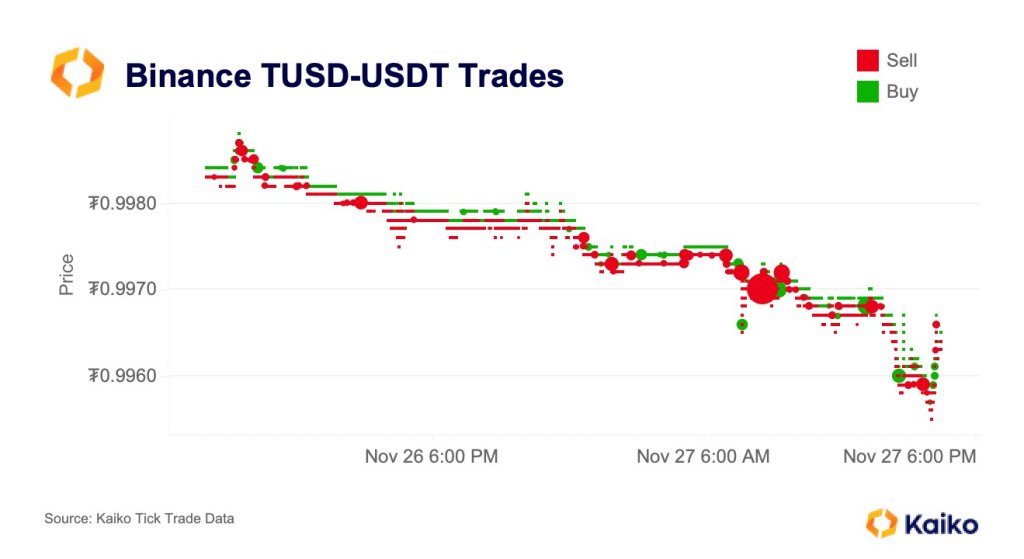
The incident highlights the potential impact of large order blocks on liquidity and the potential for slippage. TUSD, theoretically backed by USD and issued by TrustToken, is popular in Binance, an exchange that delisted USDC and 2023.
Because of this limitation, TUSD is one of the most liquid stablecoins paired with leading coins like Bitcoin (BTC). However, despite its popularity, it trails Tether (USDT), the world’s largest stablecoin by market cap.
The TEURO Mystery
This depegging occurred a few weeks after tough security questions were raised about TUSD. In mid-October, the minter was forced to disclaim TEURO, a token deployed from the same address, suggesting that private keys associated with TUSD may have been compromised.
Curiously, funds tied to TEURO, the fake token, were also linked to the deployment of TCNY, another fake token unaffiliated with TrueUSD. Following these incidents, the community began raising questions about the security of the stablecoin and, more importantly, its underlying infrastructure.
This was expected, considering that a centralized entity issues TUSD though all transactions are on-chain.
Despite these challenges, TrueUSD maintains that its smart contracts are secure. The company emphasizes that it has gained ownership of the TUSD minting contract since the end of 2020.
In early May 2023, TUSD depegged, rising to as high as $1.20 on multiple exchanges, particularly on Binance. This was attributed to an increase in activity on the SUI farming pool.
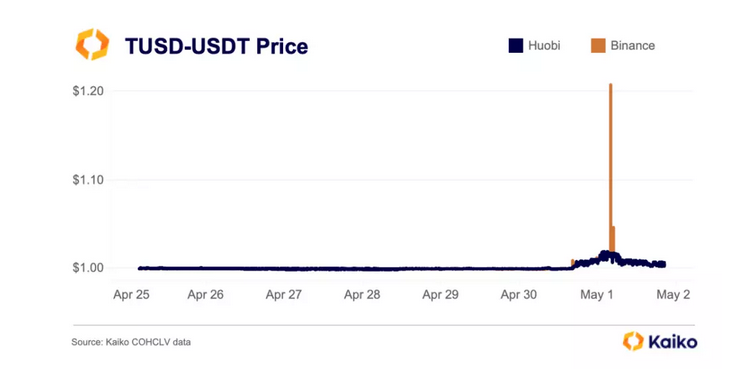
Still, this is not the first time popular stablecoins have depegged. In March 2023, USDC and DAI, two of the world’s largest stablecoins, depegged, leading to widespread fear in the market. However, the team restored parity. Moreover, to improve confidence, stablecoin issuers regularly publish attestation reports.
Santiment Reveals Trigger Behind Bitcoin Rally: Will This Signal Reignite?
The on-chain analytics firm Santiment has explained how Tether (USD) and USD Coin (USDC) exchange inflows preceded the recent Bitcoin rally.
Bitcoin Rally May Restart If Stablecoins See Further Exchange Deposits
In a new post on X, Santiment discussed the trend in the supply of exchanges of various assets in the cryptocurrency sector. The “supply on exchanges” is an indicator that keeps track of the percentage of the total circulating supply of the given coin currently sitting in the wallets of all centralized exchanges.
The below chart shows the trend in this indicator for Bitcoin (BTC), Ethereum (ETH), Chainlink (LINK), Polygon (MATIC), Tether (USDT), and USD Coin (USDC) over the past few months.
Depending on what type of asset it is, the significance of the supply on exchanges can differ. In the case of volatile assets like Bitcoin, the supply being stored on these platforms may be considered the available selling supply of the asset, as one of the main reasons investors may deposit their coins to the exchanges is for selling.
Thus, when this indicator trends up for these cryptocurrencies, it’s a potential sign that selling pressure in the sector is going up. The graph shows that Polygon has seen 0.7% of its supply move to exchanges in the past month, which could be a bearish sign for its price.
On the other hand, Bitcoin has observed withdrawals equivalent to 0.33% of its supply during the same period. Such a decline in the indicator can suggest that investors may participate in accumulation, as they are taking their coins off towards self-custodial wallets.
As for the stablecoins, an increase in the supply on exchanges also suggests that investors wish to swap these tokens. This selling of stables, though, actually provides a buying boost to the volatile side of the market, as the investors may use these assets to shift into Bitcoin and others.
As the chart shows, both Tether and USD Coin saw the exchange supply rise between August and October. More specifically, USDT and USDC observed 3.54% and 0.72% of their supplies moving into these platforms, respectively. “These transfers were the predecessor to the crypto-wide rally from late October to mid-November,” explains Santiment.
In the past month, however, 3.1% of the Tether supply has left these platforms, while the USD Coin has observed the metric move sideways. This would suggest that buying pressure has stopped rising, and the opposite may occur.
“After a cooldown, USDT & USDC returning to exchanges will be crucial to seeing market caps continuing to increase for a big final 5 weeks of 2023,” notes the analytics firm.
BTC Price
Bitcoin has registered some drawdown today as the asset’s price has now slipped under the $36,800 mark.
Rethinking Bitcoin ‘dominance’ at 51% — A misleading metric?

Bitcoin dominance is a largely redundant metric — if you believe BTC and crypto “altcoins” should be in the same category at all that is.
Tether Deposits of $1B With UK Financial Firm Are at Center of High Court Battle: FT
Tether deposited the funds with a subsidiary of investment bank Britannia Financial, according to the report, which cited filings made in the High Court.
Tether Freezes $225M Linked to Human Trafficking Syndicate Amid DOJ Investigation
Stablecoin issuer Tether has frozen $225 million worth of its stablecoin following an investigation by the U.S. Department of Justice (DOJ) into an international human trafficking syndicate in Southeast Asia.
